Introduction: Before the introduction of the electric telegraph in the 1840s, signals were carried over long distances by various optical methods: signal fires, flags, and semaphores. In this article Bill Glover gives the history of a semaphore telegraph system which ran along the Welsh coast and in to Liverpool.
A contemporary account from the Mechanics’ Magazine of the construction and operation of the telegraph is appended.
|
Liverpool - Holyhead Semaphore Telegraph
Prior to the establishment of the Semaphore Telegraph ships approaching Liverpool were signalled to their owners by means of flags on Bidston Hill. At its peak there were 103 poles and masts sited on the hill. The watchman who reported the signals was initially located on a warehouse in Chapel Street, then on the tower of St. Nicholas Church and lastly on Tower Buildings.
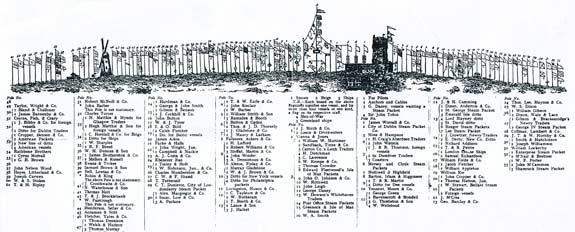
Bidston Hill: flags used for signalling the arrival of ships heading for Liverpool |
In 1824 the Liverpool Dock Trustees applied to Parliament for authority to make improvements to Liverpool Docks and in response an Act of Parliament was passed on 27 June 1825 ‘for the further improvement of the Port, Harbour, and Town of Liverpool,’ which authorised the Liverpool Dock Trustees to:
“establish a speedy Mode of Communication to the Ship-owners and Merchants at Liverpool of the arrival of Ships and Vessels off the Port of Liverpool or the Coast of Wales, by building, erecting and maintaining Signal Houses, Telegraphs or such other Modes of Communication as to them shall seem expedient, between Liverpool and Hoylake, or between Liverpool and the Isle of Anglesea.”
The following year the Trustees authorised Barnard Lindsay Watson to carry out a survey. Watson reported back that the cost of the line he proposed would be £1700 for the stations and appropriate equipment. He recommended stations at Liverpool, Bidston, Hoylake, Golden Grove, Hill Beyond Abergele, Great Ormes Head, Round Table Penmon, Llaneilian, Llanfaithlu, Holyhead. On 1 August 1826 the sub-committee set up to oversee the project reported in favour and work commenced immediately. The line was amended and stations were erected at Liverpool, Bidston, Hilbre Island, Voel Nant, Foryd, Llysfaen, Great Ormes Head, Puffin Island, Point Lynas, Carreglwyd, Holyhead.
Route of the telegraph after the 1841 changes
Holyhead Mountain - Cefdnu - Point Lynas - Puffin Island - Great Ormes
Head
-
Llysfaen - Foryd - Voel Nant - Hilbre Island - Bidston - Liverpool
View Holyhead-Liverpool Semaphore Telegraph in a larger map |
The stations consisted of basic living accommodation, the signalling equipment being a ships mast about 50 feet high fitted with three pairs of moveable arms. The top pair indicated ‘hundreds,’ the middle pair ‘tens’ and the bottom pair ‘units.’
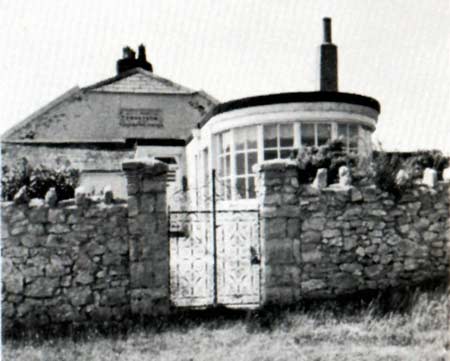
Llysfaen Station, now privately owned |
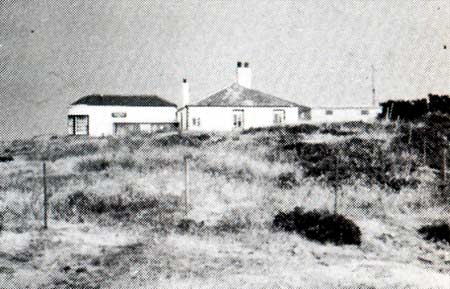
Point Lynas Station, now privately owned |
Signalling was based on the transmission of numbers based on a code produced by Barnard Watson, published as “Watson’s Liverpool Telegraphic List of Ships’ Names, with the method of making signals, and a table showing the time of high water of the principal headlands and harbours.” This assigned a number to each ship, but included only ships registered at Liverpool. Later versions expanded the listing to other ships; for example, this 1840 edition: “Watson’s General Telegraphic List of Ships’ Names, for Vessels of all Nations”.
On approaching Holyhead an incoming ship would first transmit its number by means of signal flags and if any further information needed to be sent the appropriate signal would be sent from the ship. These messages would then be relayed to Liverpool where the owners or their agents could arrange a berth and storage facilities for their goods or provide any additional services required by the vessel.
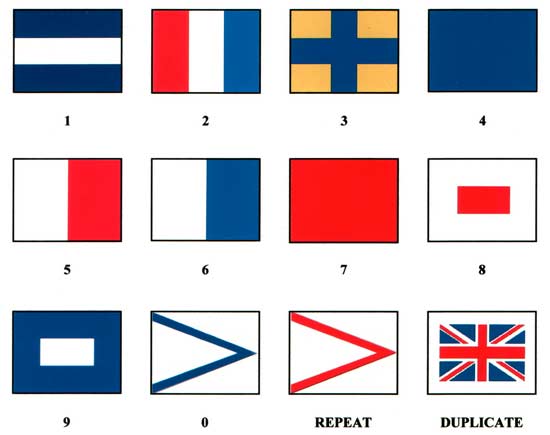
Flags used by ships to signal Holyhead Semaphore Station |

Semaphore signals used on the Holyhead Liverpool Semaphore Telegraph |
The first ship to be reported was the Napoleon on 26 October 1827, the news of its safe arrival in England was taken back to its American owners by the Josephine. This message travelled as far as Bidston, completing its journey by messenger, at the time the Liverpool station was unfinished. The first message passed over the completed line on 5 November 1827 reported a change of wind direction at Holyhead from SW. to W. Transmission time of this message was 5 minutes.

Letter sent from Liverpool to Alabama via Charleston on the SS Nimrod:
“The Victoria from New York was telegraphed this afternoon” |
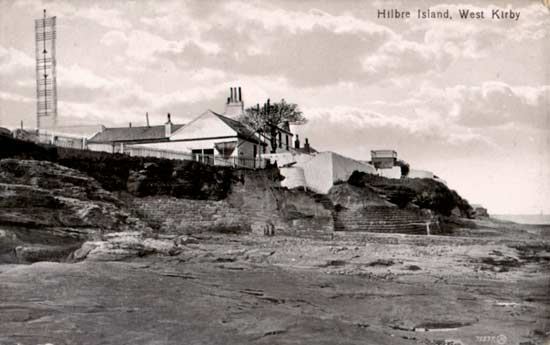
Hilbre Island Signal Station, West Kirby |
During 1840-41 the stations were rebuilt with proper living accommodation and this time with two wrought iron towers, each with two pairs of moveable arms. The exception to this was Port Lynas, which was fitted with two towers but did not have its accommodation replaced until 1854.
Three stations were moved during the rebuilding: Carreglwyd was abandoned and the new station was built at Cefndu, and Voel Nant was moved about 400 feet down the hill on which it was situated. Foryd was moved twice; the second time because the Chester-Holyhead Railway Company wanted the land on which the second station stood.

The Great Orme goats feature prominently in this engraving of the Great Orme telegraphic station, which was built in 1826, rebuilt in 1841, and closed in 1863. The arms display the number 142 |

Voel Nant (Foelnant) Telegraph Station, Prestatyn |
With the four sets of arms it was now possible to signal as follows:-
Top left pair, ‘Thousands’;
Bottom left pair ‘Hundreds’;
Top right pair ‘Tens’;
Bottom right pair ‘Units’.
The positions of the arms for the various numbers were the same as on the single masts. The code used was one devised by Lieutenant William Lord RN.
The Semaphore was finally abandoned in 1861.
A story on the speed of the system after it had been in use for about nine years was published in a number of newspapers in 1836. This version is from the Shrewsbury Chronicle issue of 21 October that year:
EXTRAORDINARY RAPIDITY OF COMMUNICATION.
We have been permitted to make extracts from the official log book kept at the Liverpool Telegraph office, and by it we are in possession of instances of such extraordinary rapidity of communication as appears almost incredible.
It appears to be a rule in this office frequently to send a communication exactly at one o’clock, through the whole line from Liverpool to Holyhead, in order that the different signal-men may regulate their time-pieces: this is done by a peculiar signal made exactly as the clock strikes one, which notifies the time, and asks the question, “is there any thing to report?” An acknowledgement or answer to this is returned, either “Yes,” or “No,” as the case may be. The distance from Liverpool to Holyhead, from station to station, is 72 Miles, hence there and back 144 miles, and this signal and answer is considered unusually long if it occupies one minute.
We find from the extracts above-mentioned, that in the month of September, in which by-the-by, we have had much stormy and bad weather, this signal has been sent on 18 different days: the distance the signal must have passed in these 18 times must be 2592 miles, which has been done in the incredibly short space of 16 minutes and five seconds, being an average of 161 miles per minute. In 17 of the days mentioned, the distance being 2448 miles, the time occupied was 14 minutes five seconds, average 175 miles per minute. In 11 of the shortest periods, the distance was 1584 miles, time occupied 7 minutes 5 seconds, average 223 miles per minute.
In taking the five quickest communications during the month, we find the distance to have been 720 miles, the time occupied two minutes 36 seconds, being an average of 288 miles per minute. The shortest time during the month was on the 10th, when the signal passed, and the answer was received in 25 seconds. When it is considered that there are 11 different telegraph stations, and only one man at each station, this will appear the more extraordinary, and speaks favourably of the management of Lieutenant Watson, under whose superintendence the telegraph was first established and still continues.
–Liverpool Paper.

Commemorative teapot:
“The Telegraph Station, Llandudno”
This view is actually of the lighthouse, halfway down the hill.
Detail of the image |
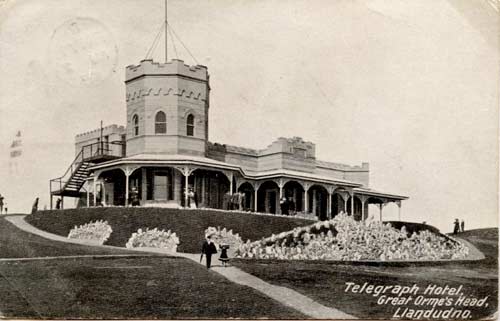
Telegraph Hotel, Great Orme’s Head, Llandudno
Built on the site of the Telegraph Station, near the summit, the hotel was taken over by the RAF in 1939 and used as a Radar Station. The hotel and the lighthouse are still there today. |
The Electric Telegraph
In 1850 Edwin Clarke approached the Trustees with regard to replacing the Semaphore with an electric telegraph, but his offer was turned down, as was the 1851 approach. In March 1855 the Mercantile Association made its feelings known to the Trustees about the state of the telegraph. A year later the Trustees finally bowed to the inevitable and approached the Electric Telegraph Co and the Magnetic Telegraph Co for quotes, both of which were rejected. They undertook the work themselves using contractors to build the landlines and lay the cables.
Holyhead was linked to Point Lynas by landline; Point Lynas to Great Ormes Head by submarine cable; Great Ormes Head to Voel Nant, again by landline. There was then a submarine cable to Hilbre Island; another submarine cable to the east bank of the River Dee; a landline to Bidston; and finally a connection to Liverpool via a cable under the River Mersey. The cables were manufactured and laid by Glass Elliot & Co in 1858, using the chartered vessel Resolute.
At Holyhead and Great Ormes Head the electric telegraph was first installed in the Semaphore Station but later moved, in the case of Holyhead to a house near the South Stack lighthouse, and on the Great Orme to the lighthouse itself.
The line was never a great success and the cables gave continual problems. In 1860 Mr. Evans, the Line Superintendent, reported that the “electric telegraph between Liverpool and Holyhead has been several times interrupted by accidents to the cable. It is now in good working order between Birkenhead and Holyhead. It was found impossible to maintain the cable between Point Lynas and the Great Orme and so it was replaced by a landline.” The cable across the Mersey also suffered damage by ships’ anchors and it was not until 5 February 1861 that the electric telegraph connected Liverpool to Holyhead.
These extracts from an article in the Mechanics’ Magazine of 24 November 1827 give further details of the semaphore telegraph’s construction and operation.
LIEUTENANT WATSON’S TELEGRAPH
A new system of telegraphic communication has been just established between the ports of Liverpool and Holyhead, which is remarkable both for the novel construction of the telegraphs, and the new purposes to which they are applied. The lines of telegraphs hitherto established in England and France (the only two countries in which this mode of transmitting intelligence has yet been introduced) have been wholly employed for government objects. We ought, perhaps, to except the line between London and Newmarket, which the well-known Richard Lovell Edgeworth established in 1767, to enable his eccentric and sporting friend, Sir Francis Blake Delaval, to obtain early tidings of the fate of his turf speculations; but it existed for so short a time, and was employed to so limited an extent, that it may be considered as but giving an evanescent hint, how applicable this system of communication might be made to all sorts of purposes.
The line of telegraphs which has commenced working between Liverpool and Holyhead, is undoubtedly the first which has been established for commercial and private correspondence, and for the common benefit of all who choose to avail themselves of it (with the restrictions afterwards mentioned). It owes its formation to the ingenuity and enterprise of Lieutenant Watson, and to the public spirit of the trustees of the Liverpool Docks, who have defrayed the whole expense (about £2000), and allow the use of it, gratuitously, to the owners, agents, and captains, of all vessels paying dock dues.
This line consists of ten different stations, viz, Liverpool, Bidston, Hilbre Island, Voel Nant, Llysfaen, Great Ormes Head, Puffins Island, Llaneilian, Gareglwyd, and Holyhead; keeping, it will be observed, along the coast the whole way—the weather being found more frequently clear in the vicinity of the sea than inland. The distance, in a right line, along these stations, is seventy-two miles; making the average distance between each, eight miles.
...

Watson’s Telegraph |
Construction of Lieut. Watson’s Telegraph.
The telegraph of Lieut. Watson, as represented in the engraving prefixed to this article, consists of a mast of Baltic timber, 50 feet high, and 22 inches in diameter (including the oak fishes or slabs girt round it with iron hoops); it is stayed from the top by four strong chains fixed into the rock. There is also a top-mast 27 feet high. In the principal mast are fixed three pairs of arms, moveable by pulleys and halliards* playing in grooves cut through the centre of the mast, and worked from a small observatory built round the foot.
*The halliards are made partly of chain and partly of rope; the lower part is of rope, which is made as short as possible, from its liability to be affected la length by the weather.
The arms are of African oak, painted black, and measure 7 feet 6 inches long by 16 inches wide; when not extended, they fall into the grooves of the mast, and are invisible.
Each of the three pairs of arms is capable of assuming six positions, with only one arm extended at once, viz. 1st, an oblique inclination upwards at an angle of 45 degrees; 2d, a horizontal position; and 3d, an oblique inclination downwards. Three other positions are assigned for each pair, which require both the arms to be extended at once, as is shown in the drawing.
This telegraph, is adapted to the numerical system; that is, all words, names, sentences, &c. are expressed by [numbers or figures previously arranged in a printed vocabulary. It is also as capable of spelling, when a proper name or uncommon word should occur, as any other telegraph. The numerical system may be briefly explained. Each number, as we have said, is made to signify a certain letter, word, or sentence, according to a fixed system. The first 26 numbers signify the letters of the alphabet; 1 signifies A, 2 B, 3 C, &c. The numbers from 27 to 58 are appropriated to the points of the compass; 27 signifies North, 28 N. by E. &c. The numbers from 62 to 185 are appropriated to portions of time, from a second to two years, and including the hours of the day, and days of the month. The numbers beyond this, to the extent of more than seven thousand, are appropriated to a vocabulary of words and sentences, which will be best understood by the following specimen from the work Lieut. Watson is about to publish:—
No.
180 A.
187 Aback.
188 Heave all aback.
189 Taken aback.
190 Abaft v. Aft.
191 Abaft the beam.
etc.
After the vocabulary comes a list of merchants’ names, to the number of some hundreds, each of which has its several number in the printed work. Then follows a gazetteer, including many hundreds of seaports, towns, and countries. And last of all come the names of vessels belonging to or frequenting the port of Liverpool.
It may seem difficult to express with certainty so many different numbers by the telegraph; but, when explained, the process is quite easy. The total number of distinct words, names, &c. in the vocabulary, is nearly 10,000, which are divided into classes of 999 each. Now, the telegraph can express any number from 1 to 999 at a single operation. It has been seen that each pair of arms is capable of nine positions, and to these positions the figures from 1 to 9 are determinately affixed. It is then arranged that the uppermost pair of arms indicate hundreds, the middle pair tens, and the lowest pair units. Thus, suppose one of the upper arms to indicate 2, the middle arm 5, and the lower arm 3, the number is 253: suppose the upper pair to indicate 7, the middle pair 8, and the lower pair 9, the number would be 789. A cypher or 0 is not needed, because the absence of any movement in the middle or lower arms would sufficiently indicate the cypher. Suppose No. 1 to be extended in the upper pair, without any indication in the pairs below, the number would be 100: suppose No. 1 to be extended in the middle pair, without any indication either of the upper or lower pairs, the number would be 10.
But as the telegraph will only express three figures at a time, the number indicated cannot be above 999. To increase the powers of the instrument, therefore, nine different classes are made, each of them containing 999 numbers. The signal man, in making his signal, indicates in the first instance, by the upper pair of arms, of what class the number is which he is about to express. Suppose he says Class 1. No. 195: this is found, on referring to the vocabulary, to signify “Abandoned by the crew.” And so of all the other classes. By the use of combinations, such as are employed in the Admiralty Semaphore, this telegraph might express any number, however large; but Lieut. Watson thinks it better to avoid the use of these combinations, as they are not necessary in a machine so comprehensive as his, whilst they make the operations much more complicated.
The signal-man at each station is continually on the look-out for signals from the next telegraph. When he sees the first signal, he makes a signal himself to show that he perceives it; and then, going to the ropes by which the machine is worked, he repeats the signal to the next station. If the message should consist of more than one signal, as is generally the case, the first is repeated before the second is made; and thus, if the message should contain nine signals, the first part of it would be in Liverpool at the time that the last part left Holyhead. Although the signal-man does not see the arms of his own telegraph move, from being in the small house immediately beneath it, yet he has not the least difficulty in operating with precision. At the end of each halliard is an iron weight, which just balances the arms; and in this weight is a bolt, which fits into holes made in the mast at those exact points where the halliard should be pulled to, in order to raise the arms to the required positions. To render the telegraphs available for communicating with vessels along the coast, the mast can be turned round, so as to present the machine broad-side to the sea.
This brings us to the system of communicating between vessels at sea and the telegraph. For this purpose a series of nine flags is used, so differently coloured as to be easily distinguishable. Each of these flags represents a number or figure, from 1 to 9, and three of them, displayed at once at the main-top, one above the other, will indicate any number up to 999. By hoisting a signal on the fore-mast to indicate the class, it is obvious that as many numbers can be represented as by the land telegraph. If a vessel in distress were to hoist the signal of Class IV. on the foremast, and 816 by three flags at the main-top, the signal-man at the telegraph would look at the vocabulary, and instantly find that Class IV. No. 816, was "Has sprung a leak." No. 818, under the same class, would signify "Leak increases, and is dangerous." The answer might be given, Class 1. No. 196 "Do not abandon the vessel;" followed by Class VII. No. 83, and Class VI. No. 334, which together signify "A steam-boat is gone to relieve the vessel in distress."
The chief purpose to which Mr. Watson’s line of telegraphs is at present applied, is to report, first, the state of the wind daily at Holyhead; second, the vessels passing that place outward or homeward bound; third, the state of any vessel in distress, or in need of assistance, along the whole intervening line of coast; fourth, any important information, either political or commercial, from Ireland or America—made known in the latter case at Holyhead by the signals of homeward-bound vessels. But there are various other purposes which these telegraphs may be made to answer. The difficulty is to say what kind of correspondence they may not serve to conduct. We know not, indeed, that it will deprive the post-office of the love-letters which now pass through it, though we see no reason why it should not. On the contrary, its swiftness is admirably adapted for the communications of impatient lovers.
Love’s heralds should be thoughts;
Therefore do nimble-pinioned doves draw
love, And therefore hath the wind-swift Cupid
wings.
So said sweet Juliet; and had she had a telegraph, it would have made her happy, and spared her nurse’s bones; nay, it might have saved the life of her Romeo. A sigh or avow might be wafted from London to Bath or Cheltenham in a few seconds: a lover might thus most conspicuously signalize his devotion to the fair one of his heart; and the pining mistress might learn from the expanded arms of the telegraph how soon she should be restored to the arms of her betrothed. We dare to say that Lieut. Watson will assist any couple about to endure the pangs of absence, to adapt a Cupid’s vocabulary to his telegraph. Nay, we shall show them by and bye how they may do it without his assistance, and with such secrecy that the tenderest breathings may be conveyed under an impenetrable cypher. Paper may be violated, wax may be melted, but a telegraphic love-letter would be more mysterious than the enigma of the sphynx, as well as swifter than the flight of ‘Venus’ doves.’
At all events, every kind of commercial intelligence might be conveyed with certainty and secrecy by this method. The two correspondents, being each provided with a vocabulary, have only to agree to add a certain number, say 5, 6, or 7, to the numbers given to the signalman of the telegraph, and thus it would be impossible for him to understand a word. Instead of 381, the No. 386 might be given; instead of 260, the No. 265; and the correspondent at the other end, knowing that he ought to deduct 5 from each number, would immediately discover the meaning. Even more intricate methods will easily occur to every one. Between such towns as Liverpool, Manchester, Leeds, Hull, Birmingham, and London, this species of communication would be highly valuable.
In time of war, the utility of the telegraph from Holyhead to Liverpool would be extremely great. No enemy’s ship or privateer could approach any part of the coast, without its being instantly known at every station ; and all kinds of important intelligence might be conveyed with the same rapidity.
It seems very probable that many improvements may yet be made in the telegraph, to adapt it more entirely to every species of communication; though to us it appears to be already greatly simplified in the system we have described, and capable of being almost universally applied.
More information on Hilbre Island and the history of the Liverpool-Holyhead Semaphone Telegraph |

